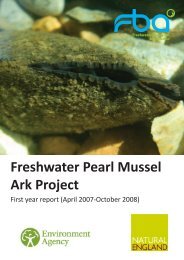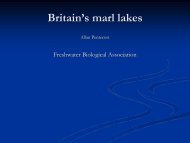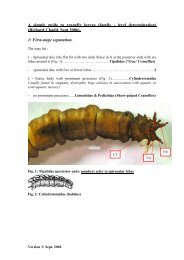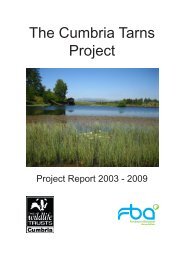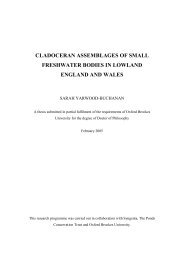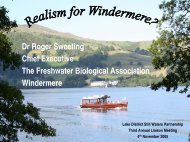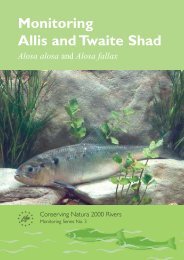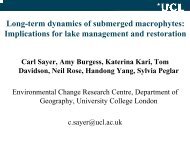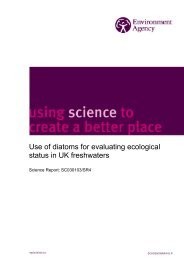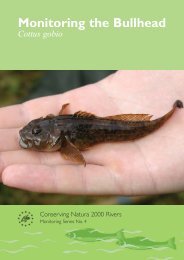EN REPORT (SCIE) F&B (3529b) - FreshwaterLife
EN REPORT (SCIE) F&B (3529b) - FreshwaterLife
EN REPORT (SCIE) F&B (3529b) - FreshwaterLife
You also want an ePaper? Increase the reach of your titles
YUMPU automatically turns print PDFs into web optimized ePapers that Google loves.
5.6.2 Species known in Britain only as pests of stored products or as commensals in<br />
houses<br />
Groups such as stored product pests and cockroaches are not included in this audit as they are<br />
not found ‘in the wild’ in England. Either their food resources are not present outside<br />
buildings or they cannot survive or reproduce outdoors in the English climate. For example,<br />
certain bruchid beetles, such as Callosobruchus chinensis, can be pests in warehouses where<br />
the larvae develop inside dried pulses. These food sources are not available in the wild in<br />
Britain and the adults could probably not survive the winter.<br />
5.7 Freshwater fish species<br />
The definition of non-native species as regards freshwater fishes has recently been reviewed<br />
(Copp and others 2005a). Synonyms of ‘non-native’ include ‘non-indigenous’, ‘alien’ or<br />
‘exotic’ and ‘foreign’; these refer to a species, sub-species, race or variety (including<br />
gametes, propagules or part of an organism that might survive and subsequently reproduce)<br />
that does not occur naturally in a geographical area; ie it did not previously occur there or its<br />
dispersal into the area was mediated or facilitated directly or indirectly by humans, whether<br />
deliberately or unintentionally (see also Manchester & Bullock 2000; Scalera and Zaghi<br />
2004). In England, some non-native freshwater fish species, from a biogeographical point of<br />
view, have exceptional status under current legislation (eg common carp Cyprinus carpio, ide<br />
Leuciscus idus, goldfish Carassius auratus, rainbow trout Oncorhynchus mykiss). These<br />
species are considered by the authorities to be ‘ordinarily resident’ in England, which de<br />
facto categorizes them as being ‘naturalized’. For current purposes, there is no distinction<br />
between these species and other non-native fishes that were introduced to, and became<br />
established in, English waters during the same era (eg pikeperch Sander lucioperca,<br />
European (wels) catfish Siluris glanis, pumpkinseed Lepomis gibbosus). For the purposes of<br />
this audit, all species not native to England are included. Of particular note as regards<br />
native/non-native status is the crucian carp Carassius carassius. This species was previously<br />
considered to be non-native to the British Isles (eg Maitland 1972), and indeed continues to<br />
be classed as such in rare cases (eg Maitland 2004). However, following assessment of<br />
archaeological evidence and pre-1960’s distribution of freshwater fishes, Wheeler (1977,<br />
2000) recognised as native to southeastern England. Therefore Crucian carp is excluded from<br />
this audit.<br />
5.8 Birds<br />
The British Ornithologists’ Union (BOU) definitions for birds are given in Table 1.<br />
Categories A and B are natives. Category C corresponds to the one used here for aliens. Of<br />
the subdivisions listed there, the great majority have type of non-nativeness ‘Introduction’ in<br />
the system proposed here. However, category C3 ‘Naturalised re-establishments’<br />
corresponds to our category ‘Formerly native’.<br />
14




